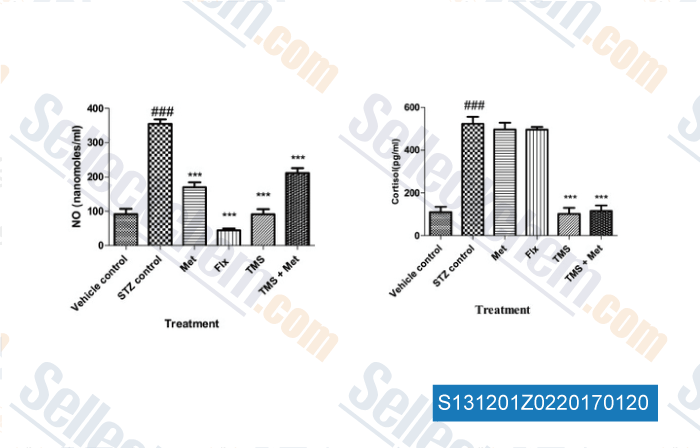|
Toll Free: (877) 796-6397 -- USA and Canada only -- |
Fax: +1-832-582-8590 Orders: +1-832-582-8158 |
Tech Support: +1-832-582-8158 Ext:3 Please provide your Order Number in the email. |
Technical Data
| Formula | C8H15N3O7 |
|||
| Molecular Weight | 265.22 | CAS No. | 18883-66-4 | |
| Solubility (25°C)* | In vitro | DMSO | 53 mg/mL (199.83 mM) | |
| Water | 53 mg/mL (199.83 mM) | |||
| Ethanol | Insoluble | |||
|
* <1 mg/ml means slightly soluble or insoluble. * Please note that Selleck tests the solubility of all compounds in-house, and the actual solubility may differ slightly from published values. This is normal and is due to slight batch-to-batch variations. * Room temperature shipping (Stability testing shows this product can be shipped without any cooling measures.) |
||||
Preparing Stock Solutions
Biological Activity
| Description | STZ (Streptozotocin) is a glucosamine-nitrosourea compound derived from Streptomyces achromogenes, which is a DNA-methylating, carcinogenic, antibiotic and diabetes inducing agent. Streptozotocin induces autophagy and apoptosis. Streptozotocin (STZ) can be used to induce animal models of diabetes. Solutions are unstable and should be fresh-prepared. |
|---|---|
| In vitro | Streptozotocin directly methylates DNA and is highly genotoxic, producing DNA strand breaks, alkali-labile sites, unscheduled DNA synthesis, DNA adducts, chromosomal aberrations, micronuclei, sister chromatid exchanges, and cell death. Free radicals are involved in the production of DNA and chromosome damage by Streptozotocin. [1] Streptozotocin is toxic to pancreatic beta cell. Exposed to 15 mM Streptozotocin for 1 hr followed by a 24 hrs recovery period induces apoptosis in murine pancreatic beta cell line, INS-1. Streptozotocin (30 mM) causes the cells to undergo necrosis (22%) as well as apoptosis (17%). [2] |
| In vivo | Streptozotocin is often used to induce diabetes mellitus in experimental animals. Streptozotocin is selectively accumulated in pancreatic beta cells via the low-affinity GLUT 2 glucose transporter. Streptozotocin (60 mg/kg) injection for 4 month induces rapid degranulation of beta cells without necrosis, development of cataracts and accumulation of glycogen in the proximal convoluted tubules of the kidney. Streptozotocin (100 mg/kg) produces lesions in the exocrine cells of the pancreas, and persistence of small, possibly secretory, granules in the Golgi zone of beta cells in rats of ‘Streptozotocin diabetes’. [3] Streptozotocin is found to be carcinogenic in rats, mice and hamster. A single administration of Streptozotocin is able to induce tumors in kidney, liver, lung, pancreas, uterine and liver tumors in hamster. Intraperitoneally injected with Streptozotocin (100-150 mg/kg) for normotensive Wistar Kyoto rats (WKY) for 12 months induces carcinogenesis with tumors incidence of 70% in liver, 20% in kidney and 10% in liver and kidney. [4] |
Protocol (from reference)
| Cell Assay: |
|
|---|---|
| Animal Study: |
|
References
Customer Product Validation

-
, , Pharmacol Rep, 2017, 69(2):358-364
Selleck's STZ (Streptozotocin) has been cited by 26 publications
| D-mannose promotes diabetic wound healing through inhibiting advanced glycation end products formation in keratinocytes [ Mol Med, 2025, 31(1):15] | PubMed: 39827347 |
| Targeting TANK-binding kinase 1 attenuates painful diabetic neuropathy via inhibiting microglia pyroptosis [ Cell Commun Signal, 2024, 22(1):368] | PubMed: 39030571 |
| Transient but not chronic hyperglycemia accelerates ocular glymphatic transport [ Fluids Barriers CNS, 2024, 21(1):26] | PubMed: 38475818 |
| Hyperglycemia-induced Sirt3 downregulation increases microglial aerobic glycolysis and inflammation in diabetic neuropathic pain pathogenesis [ CNS Neurosci Ther, 2024, 30(8):e14913] | PubMed: 39123294 |
| KRT17 From Keratinocytes With High Glucose Stimulation Inhibit Dermal Fibroblasts Migration Through Integrin α11 [ J Endocr Soc, 2024, 8(2):bvad176] | PubMed: 38205163 |
| A glucose-blue light AND gate-controlled chemi-optogenetic cell-implanted therapy for treating type-1 diabetes in mice [ Front Bioeng Biotechnol, 2023, 11:1052607] | PubMed: 36845170 |
| Human pluripotent stem-cell-derived islets ameliorate diabetes in non-human primates [ Nat Med, 2022, 10.1038/s41591-021-01645-7] | PubMed: 35115708 |
| Targeting ferroptosis suppresses osteocyte glucolipotoxicity and alleviates diabetic osteoporosis [ Bone Res, 2022, 10(1):26] | PubMed: 35260560 |
| Inhibition of HDAC6 With CAY10603 Ameliorates Diabetic Kidney Disease by Suppressing NLRP3 Inflammasome [ Front Pharmacol, 2022, 13:938391] | PubMed: 35910382 |
| Establishment and Characterization of NCC-PMP1-C1: A Novel Patient-Derived Cell Line of Metastatic Pseudomyxoma Peritonei [ J Pers Med, 2022, 12(2)258] | PubMed: 35207746 |
RETURN POLICY
Selleck Chemical’s Unconditional Return Policy ensures a smooth online shopping experience for our customers. If you are in any way unsatisfied with your purchase, you may return any item(s) within 7 days of receiving it. In the event of product quality issues, either protocol related or product related problems, you may return any item(s) within 365 days from the original purchase date. Please follow the instructions below when returning products.
SHIPPING AND STORAGE
Selleck products are transported at room temperature. If you receive the product at room temperature, please rest assured, the Selleck Quality Inspection Department has conducted experiments to verify that the normal temperature placement of one month will not affect the biological activity of powder products. After collecting, please store the product according to the requirements described in the datasheet. Most Selleck products are stable under the recommended conditions.
NOT FOR HUMAN, VETERINARY DIAGNOSTIC OR THERAPEUTIC USE.
